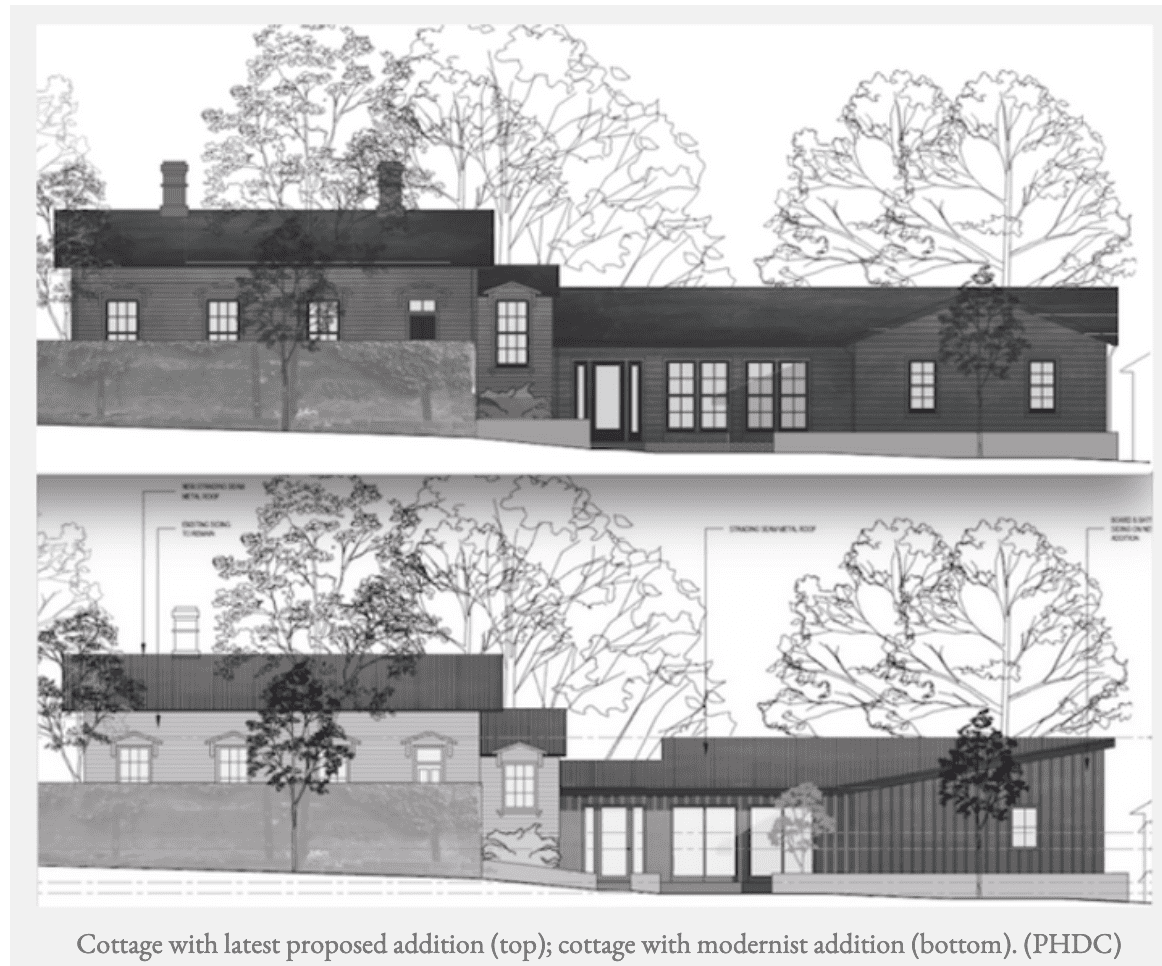Search Posts
Recent Posts
- Rhode Island Legislature Highlights Accomplishments for the 2025 Session June 25, 2025
- Sports in RI: Cody Tow, Volleyball Past, Present and Into His Future – John Cardullo June 25, 2025
- Need a Break? Time for Sour Grapes – Tim Jones June 25, 2025
- Rhode Island Weather Forecast for June 25, 2025 – Jack Donnelly June 25, 2025
- It is what it is: Commentary on 6.25.25 with Jen Brien June 25, 2025
Categories
Subscribe!
Thanks for subscribing! Please check your email for further instructions.

History wins one on the East Side – David Brussat
by David Brussat, Architecture Here and There, contributing writer on architecture
For a year or more the vultures circled over an old cottage between Williams and John streets just off of historic Benefit Street. A developer’s plan to add an ultra-modernist addition to a historic cottage at 59 Williams, and then to plop a pair of junkster modernist “town homes” behind the cottage, facing John, at the expense of a woods that had survived since the 19th century, placed the historic character of College Hill and Fox Point at dire risk. Had it proceeded, the development would have proved an irresistible precedent for even worse.
I now learn that the developer has called off his dogs. The neighborhood is safe, or as safe as any place can be in a city whose leadership prefers to eat the seed corn of its history. Two proposed modernist Brown University dorms still threaten to wreck a block on Brook Street between Power and Charlesfield streets nearby. Brown has offered to review the design of the two dorms, but it may take a sterner rattling of Brown’s cage to force the school’s leadership to see reason.
A correspondent sent me word that the plot of land with the woods on it was suddenly for sale for $1 million. Digging down further into the Zillow posting, I discovered that the Williams Street cottage had sold on June 2 for $580,000; the buyer is now seeking to flip it for $1.6 million. That suggests that the renovations recently approved by the city will go forward. But a deep source that I contacted to double-check this news told me that the developer had altogether abandoned the condo townhouse part of the project.
The cottage renovations will be historic in style, and quite easy on the eye. That is because the neighborhood maintained a constant opposition to the modernist design proposed by architect Friedrich St. Florian (with its patently clichéd awkwardly raking roof). The Providence Historic Preservation Commission, which oversees plans for the city’s historic districts, delayed deciding on the renovations for three sessions. This probably caused the developer to agree to ditch the modernism and go with a much more historically sensitive design, no doubt to St. Florian’s dismay. Apparently, at some point, the developer decided to ditch the whole project, which was no doubt running far higher in costs than he expected (largely due to St. Florian’s goading the opposition’s tenacity).
There are lessons to be learned here. Members of the HPC know what their jobs are, but are willing to stray in order to curry favor with wealthy developers and fashionable designers like St. Florian. They must be pressured to permit only those changes that will fit into a district’s historic character – using definitions of aesthetics that would feel proper in the eyes of an average resident of the district, not the kooky fake notions dreamed up by the professional designer class, who are poorly educated in all matters of design, and inflict their folly on citizens who have invested deeply in historical architecture – because they trust officials to do their jobs. The words “historic preservation” in the title of their organization must be taken more seriously.
In this process of, um, reminding officials of their duty, the neighbors almost managed to snatch defeat from the jaws of victory by bowing and scraping to a designer, St. Florian, who seems to have forgotten why he is celebrated around here. He designed one of the few traditional shopping malls in the United States, which is lovely in spite of its design flaws. And he designed a classical World War II memorial on the Mall in Washington, D.C., at a time when most designers were testing the patience of American citizens by designing goofy modernist memorials and museums in that sacred precinct.
On the same wavelength, some of the opponents did not realize how counter-productive it was to assert that they did not oppose modern architecture – except in their neighborhood. Such a hypocritical NIMBY contradiction enabled the developer (and St. Florian) to persuade themselves that the opposition was not serious and that if they could hold on long enough, they could make a lot of money by wrecking a beautiful neighborhood.
St. Florian probably did not make things any easier for his boss by using the time between commission sessions to make his designs for the cottage addition and the townhouses more, not less, ridiculous. His opponents can thank the great architect for throwing his doubt of their resolve back in their faces.
It is impossible to know what straw of opposition, or which commission delay, will break a developer’s back and force him to throw in the towel. The neighbors on Williams and John street can celebrate the fact that they did indeed manage to trip over the last straw.
It is possible that I am reading these Zillow tea leaves wrong and that the project will continue, possibly with an infusion of new cash, or with a new developer. Or that I should have done more digging to confirm my information. Neighbors must remain vigilant along Williams and John even as they gird their loins to fight Brown on Brook. However, if they are willing to learn the lessons of their victory – be even clearer that your opposition is to anti-historical design – they will show the next set of brutalizers that they are a force to be reckoned with.
To read Brussat’s blog, go to: https://architecturehereandthere.com/2021/07/10/history-wins-on-williams-st/
_____

My freelance writing and editing on architecture and others addresses issues of design and culture locally and globally. I am a member of the board of the New England chapter of the Institute of Classical Architecture & Art, which bestowed an Arthur Ross Award on me in 2002. I work from Providence, R.I., where I live with my wife Victoria, my son Billy and our cat Gato. If you would like to employ my writing and editing to improve your work, please email me at my consultancy, dbrussat@gmail.com, or call (401) 351-0457 https://architecturehereandthere.com/
